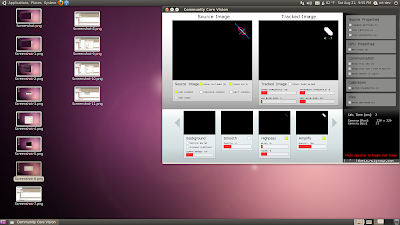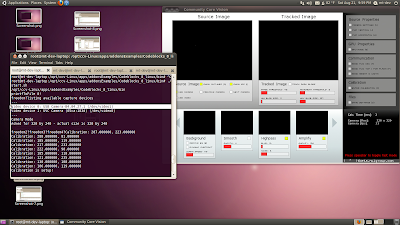All right so I have been away for a couple weeks now but I am back!
I see a couple of you have had success and some are having problems. I am going to look at the problems and see if I can't resolve them.
Also here is what is coming up soon:
1. I am going to remaster this into a live-cd so that you can just download the iso and have a working fresh install of ubuntu 10.04 plus CCV.
2. The next tutorial will follow my development of an openGL based windowing system.
This windowing system will incorporate a tuio listner so that everything will be multitouch, even the login after you press the power button on your computer. :)
Tuesday, August 31, 2010
Saturday, August 21, 2010
STEP 6: Compiling CCV on Ubuntu 10.04

Now we are going to compile CCV for Ubuntu 10.04.
Make sure you DO NOT start here. You need to start at the beginning of the blog and follow from there, if you try to do this tutorial BEFORE this one, your ps3 eye will NOT work with CCV.
The following is a modified tutorial based off of x29a's post on the nui group forums.
Enter the following commands:
sudo apt-get install subversionsudo su-
cd /opt svn co http://nuicode.svnrepository.com/svn/tbeta/trunk/tbeta/Linux/ ccv-Linuxcd /opt/ccv-Linux/scripts/ubuntuchmod +x *.sh./install_codeblocks.sh./install_dependencies.shapt-get install libpoco-devapt-get install gppcd /opt/ccv-Linux/cd apps/addonsExamples/Codeblocks_8_linux/
Unzip it to your Documents folder.
Back in your terminal enter the following command:
nautilus
and delete the following files:
- Community Core Vision.cbp
- Community Core Vision.depend
- Community Core Vision.layout
- Makefile
Close Nautilus. Back in the terminal enter the following commands:
cd /opt/ccv-Linux/libs/fmodex/librm libfmodexp.so libfmodex.soln -s libfmodex-4.22.00.so libfmodex.soln -s libfmodexp-4.22.00.so libfmodexp.so
cd /opt/ccv-Linux/apps/addonsExamples/Codeblocks_8_linux/bin/libsrm libfmodexp.so libfmodex.soln -s libfmodex-4.22.00.so libfmodex.soln -s libfmodexp-4.22.00.so libfmodexp.so
cd /opt/ccv-Linux/codeblocks apps/addonsExamples/Codeblocks_8_linux/Community\ Core\ Vision.cbp
You may get some errors, just click OK and ignore them.
CCV should now have successfully built. Close Codeblocks and go back to your terminal and enter the following commands:
cd /opt/ccv-Linux/apps/addonsExamples/Codeblocks_8_linux/bingedit start.sh
#!/bin/sh
echo $(pwd)
export LD_LIBRARY_PATH=$(pwd)/libs/
./Community_Core_Vision
chmod +x start.shcd datagedit config.xml
To Start CCV enter the following commands in your terminal:
cd /opt/ccv-Linux/apps/addonsExamples/Codeblocks_8_linux/bin./start.sh

STEP 5: Testing the ps3 eye with VLC.
It is time to test out our ps3 eye!
First off I want to say that I am using a wonderfully modified ps3 eye made by Nolan at Peau Productions. I have a 780nm band pass filter, which is why my vlc stream will appear a very dark orangish / red.
Click on Applications --> Sound & Video --> VLC Media Player
You should see the following:

Now on VLC, click on Media --> Open Capture Device
If your computer, like my laptop has a built in video camera, your ps3 eye will not be /dev/video0 it will be /dev/video1 assuming your ps3 eye is the only other webcam you have hooked up to your computer.
Under the video device name put in your ps3 eye. In my case it looks like this since my laptop has a built in webcam:

Press play and see your ps3 eye working!

First off I want to say that I am using a wonderfully modified ps3 eye made by Nolan at Peau Productions. I have a 780nm band pass filter, which is why my vlc stream will appear a very dark orangish / red.
Click on Applications --> Sound & Video --> VLC Media Player
You should see the following:

Now on VLC, click on Media --> Open Capture Device
If your computer, like my laptop has a built in video camera, your ps3 eye will not be /dev/video0 it will be /dev/video1 assuming your ps3 eye is the only other webcam you have hooked up to your computer.
Under the video device name put in your ps3 eye. In my case it looks like this since my laptop has a built in webcam:

Press play and see your ps3 eye working!

STEP 4: Getting the ps3 eye to work!
The following is based off the tutorial from kaswy's page.
I have however made a couple small changes that are required. Open up your terminal and enter the following commands.
<your version> is the number that is between the 2.6. and the .tar.bz2. in my case the file is: linux-source-2.6.32.tar.bz2 so my <your version> is 32
Now type in the following command, but replace the <your version> with the proper number.
root@mt-dev-laptop:/usr/src/linux# modinfo gspca-ov534
filename: /lib/modules/2.6.32-24-generic/kernel/drivers/media/video/gspca/gspca_ov534.ko
license: GPL
description: GSPCA/OV534 USB Camera Driver(kaswy mod for MT use V0.5)
author: Antonio Ospite
srcversion: 2153E3BE52298A39177E46C
alias: usb:v1415p2000d*dc*dsc*dp*ic*isc*ip*
depends: gspca_main
vermagic: 2.6.32.15+drm33.5 SMP mod_unload modversions 586
parm: videomode: = xx //Set the videomode(see doc) (int)
parm: autogain: = [0|1] //Autogain (agc,aec,awb) (bool)
parm: gain: = [0..63] //main gain (int)
parm: exposure: = [0..255] //Exposure (int)
parm: redblc: = [0..255] //Red Balance (int)
parm: blueblc: = [0..255] //Blue Balance (int)
parm: sharpness: = [0..63] //Sharpness (int)
parm: vflip: = [0|1] //Vertical flip (bool)
parm: hflip: = [0|1] //Horizontal mirror (bool)
root@mt-dev-laptop:/usr/src/linux#
The important part is the description where it has v0.5 and kaswy's name.
Go ahead and enter the following commands:
On to modifying and installing unicap
Enter the following commands:
I have however made a couple small changes that are required. Open up your terminal and enter the following commands.
sudo -iapt-get install kernel-package libncurses5-dev wget bzip2 build-essentialcd /usr/srcapt-get install linux-source
ls
<your version> is the number that is between the 2.6. and the .tar.bz2. in my case the file is: linux-source-2.6.32.tar.bz2 so my <your version> is 32
Now type in the following command, but replace the <your version> with the proper number.
tar --bzip2 -xvf linux-source-2.6.<your version>.tar.bz2ln -s linux-source-2.6.<your version> linuxcd linux
tar --bzip2 -xvf linux-source-2.6.32.tar.bz2ln -s linux-source-2.6.32 linuxcd linux
wget http://kaswy.free.fr/sites/default/files/download/ps3eye/0.5/ps3eyeMT-2.6.31-10-generic.patchpatch -p1 <ps3eyeMT-2.6.31-10-generic.patchmake oldconfigcp /usr/src/linux-headers-$(uname -r)/Module.symvers /usr/src/linuxmake modules_preparemake SUBDIRS=drivers/media/video/gspca modulescp drivers/media/video/gspca/gspca_ov534.ko /lib/modules/$(uname -r)/kernel/drivers/media/video/gspca/depmodmodinfo gspca-ov534
root@mt-dev-laptop:/usr/src/linux# modinfo gspca-ov534
filename: /lib/modules/2.6.32-24-generic/kernel/drivers/media/video/gspca/gspca_ov534.ko
license: GPL
description: GSPCA/OV534 USB Camera Driver(kaswy mod for MT use V0.5)
author: Antonio Ospite
srcversion: 2153E3BE52298A39177E46C
alias: usb:v1415p2000d*dc*dsc*dp*ic*isc*ip*
depends: gspca_main
vermagic: 2.6.32.15+drm33.5 SMP mod_unload modversions 586
parm: videomode: = xx //Set the videomode(see doc) (int)
parm: autogain: = [0|1] //Autogain (agc,aec,awb) (bool)
parm: gain: = [0..63] //main gain (int)
parm: exposure: = [0..255] //Exposure (int)
parm: redblc: = [0..255] //Red Balance (int)
parm: blueblc: = [0..255] //Blue Balance (int)
parm: sharpness: = [0..63] //Sharpness (int)
parm: vflip: = [0|1] //Vertical flip (bool)
parm: hflip: = [0|1] //Horizontal mirror (bool)
root@mt-dev-laptop:/usr/src/linux#
The important part is the description where it has v0.5 and kaswy's name.
Go ahead and enter the following commands:
modprobe -r gspca-ov534modprobe gspca-ov534 videomode=01 autogain=0 exposure=200 hflip=1
exit
This completes the first step to getting the ps3eye working properly.On to modifying and installing unicap
Enter the following commands:
cdmkdir unicapcd unicapwget http://unicap-imaging.org/downloads/unicap-0.9.5.tar.gztar -xvzf unicap-0.9.5.tar.gzwget http://kaswy.free.fr/sites/default/files/download/ps3eye/unicap/unicap-gspca.patchpatch-p0 <unicap-gspca.patchcd unicap-0.9.5./configuremakesudo make install
STEP 3: Getting VLC.
The next thing we need to do before anything else is get VLC. Vlc is a very versatile media player.
Click on Applications --> Accessories --> Terminal
now enter the following command:
Click on Applications --> Accessories --> Terminal
now enter the following command:
sudo apt-get install vlc
STEP 2: Install Ubuntu and Start Up.
So now that you have your Ubuntu cd, throw it in your disk drive and install it. Be careful though! If you are going to install this on a computer that already has another operating system on it you can easily erase EVERYTHING including the operating system itself.
Follow the instructions on the screen. I decided to create a user name of mt-dev for this instillation.
The computer will restart when the instillation is complete. Go ahead and log in. Connect yourself to the internet.
NOTE: This is the most important step in everything we are going to do: The very first time you log in, do not install any new programs, do not install any updates if the package manager asks you to. DO NOT INSTALL ANYTHING, unless it is in this blog, in the right order.
Follow the instructions on the screen. I decided to create a user name of mt-dev for this instillation.
The computer will restart when the instillation is complete. Go ahead and log in. Connect yourself to the internet.
NOTE: This is the most important step in everything we are going to do: The very first time you log in, do not install any new programs, do not install any updates if the package manager asks you to. DO NOT INSTALL ANYTHING, unless it is in this blog, in the right order.
Friday, August 20, 2010
STEP 1: Get Ubuntu.
The first step is to get the most current copy of Ubuntu. The reason I have chosen Ubuntu is because it is very user friendly and now days one of the most supported distro's out there.
We will be working with version 10.04.
You can get the latest version here:
http://www.ubuntu.com/desktop/get-ubuntu/download
An important note: Get the 32 bit version. I have not yet attempted this with 64 bits. That will come in the future.
Once you have the .iso file downloaded, burn it to a disk. If you don't know how to do this, follow step 2 on :
http://www.ubuntu.com/desktop/get-ubuntu/download
-----
For those of you like myself who prefer to download large files as a torrent, you can get the torrent here:
http://releases.ubuntu.com/10.04.1/ubuntu-10.04.1-desktop-i386.iso.torrent
-----
Now I am assuming that since you are interested in developing MT Apps and Systems for Linux, you have some kind of Linux background. This is the only thing I am going to assume through out this blog. If you can't get a fresh install of Ubuntu 10.04 on your system than there is no hope for you. Also, I am not responsible for any data loss or damages when you try to install a fresh copy of Ubuntu on your computer.
We will be working with version 10.04.
You can get the latest version here:
http://www.ubuntu.com/desktop/get-ubuntu/download
An important note: Get the 32 bit version. I have not yet attempted this with 64 bits. That will come in the future.
Once you have the .iso file downloaded, burn it to a disk. If you don't know how to do this, follow step 2 on :
http://www.ubuntu.com/desktop/get-ubuntu/download
-----
For those of you like myself who prefer to download large files as a torrent, you can get the torrent here:
http://releases.ubuntu.com/10.04.1/ubuntu-10.04.1-desktop-i386.iso.torrent
-----
Now I am assuming that since you are interested in developing MT Apps and Systems for Linux, you have some kind of Linux background. This is the only thing I am going to assume through out this blog. If you can't get a fresh install of Ubuntu 10.04 on your system than there is no hope for you. Also, I am not responsible for any data loss or damages when you try to install a fresh copy of Ubuntu on your computer.
Purpose of this blog.
I've been working with multi touch systems for a while now. First off I would like to say I am a strong supporter of the open source community and believe that being open helps resolve issues and drive development. Development would be the key word here. The people at nui group have a great thing going, but I feel like the development on the Linux platform has been severely hindered and is falling behind. I would like to see effort being put into developing multitouch applications and not just people trying to spend hours and hours just getting CCV or the ps3 eye to work, and then to just simply give up out of frustration. So, I will start this blog off with how to get CCV and your ps3eye working, and CCV and the ps3eye working together on Linux. Here is where things are different from the other tutorials available on the forums, I will be documenting how to do this from a fresh install of Ubuntu.
Subscribe to:
Posts (Atom)